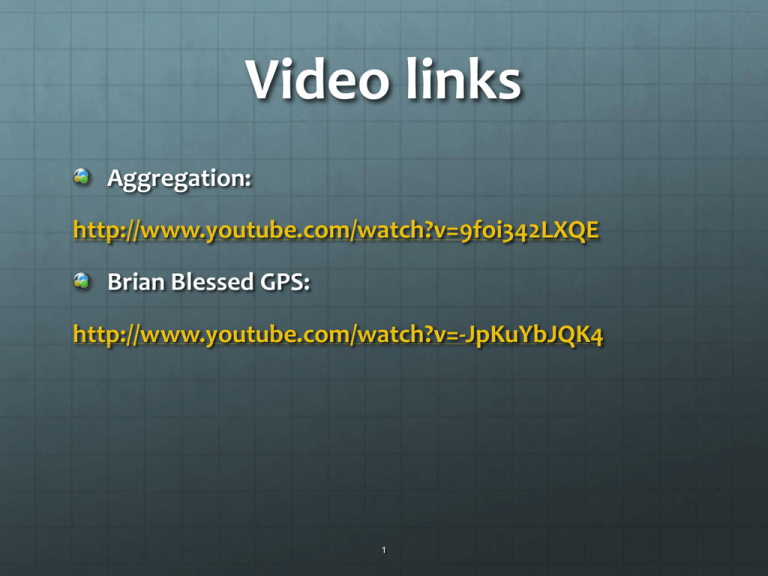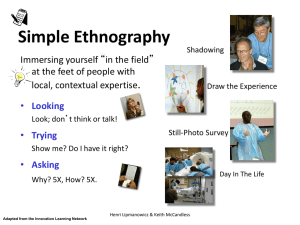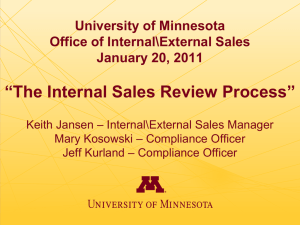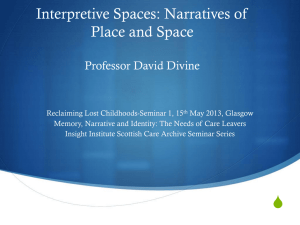PowerPoint version - Scrutable Autonomous Systems
advertisement

Video links Aggregation: http://www.youtube.com/watch?v=9foi342LXQE Brian Blessed GPS: http://www.youtube.com/watch?v=-JpKuYbJQK4 1 “Are you talking to me?” What to say when you are talking to a robot. Dr. Nava Tintarev Dept. of Computing Science University of Aberdeen 2 We are the SAsSY project This is short for Scrutable Autonomous Systems There are six of us: Logician/Computer scientist on reasoning Computer scientists on generating text from data Computer scientists on human computer interaction Psychologist, or rather a psycholinguist 3 We are the SAsSY project 4 Why I got into computing… “Yes, this system is a little bit finicky. It won’t let me put this in directly” “Machine at train station will not let me buy a ticket!” “Why is it picking this route when the other one is about 10 miles shorter?” 5 The problem… The system needs to tell us things What if the system sounded like Brian Blessed (1.152.00)? And we need to tell it some things back Or ask it questions – “this one?” No, not of the @?$!% kind… 6 Let’s talk about Robots…. ASIMO immediately recognizing customers' intention by a show of hands, Honda.com, 26 June 7 2013 What’s a computer? 8 Autonomous systems Computers that do not look like humans But they can ‘see’ and ‘think’ (calculate) and ‘react’ (according to a program) and ‘learn’ (collect new information) and ‘talk’ (send information to) people or other computers on their own. 9 Autonomous systems They can do things that we cannot do Too boring, too complicated, or maybe too dangerous Like Fukushima Sort of like a robot… 10 What could possibly go wrong? 11 What could possibly go wrong The U.S. states of Nevada, Florida and California permit the operation of autonomous cars . The first license for an autonomous car was given in May 2012. An unmanned aerial vehicle (UAV), also known as a drone, is an aircraft without a human pilot on board. The United States government has made hundreds of attacks on targets in northwest Pakistan since 2004 using drones (unmanned aerial vehicles). Drones also used for policing and firefighting, and nonmilitary security work, such as surveillance of pipelines. With great power comes great responsibility… 12 The problem Autonomous systems act on behalf of the user Should the GPS have a mind of its own? The system’s decisions are often opaque to the user Why did it turn off here? The user should be able to view and challenge decisions “Hey car, that’s not right! Why are we turning off at the next junction?” Solution: Keep people in the loop. Give them explanations! “There’s a traffic jam coming up, you’ll get home quicker taking this country road!” 13 Pilot Authority Control of Tasks (PACT) Human Monitors PACT level 5b Computer autonomy Levels of Human Machine Interface (Modified from Taylor, 2001) Computer monitored by pilot Computer does everything autonomously 5a 4b Computer chooses action, performs it and informs human Computer backed up by pilot Computer chooses action and performs it unless human disapproves 4a Human Action Computer chooses action and performs it if human approves 3 Pilot backed up by computer Computer suggests options and proposes one of them 2 Pilot assisted by computer Computer suggests options to human 1 Pilot assisted by computer only when required Human asks computer to suggest options and human selects 0 Pilot Whole task done by human except for actual operation 14 A solution: Explanations From Keith, you should go to Elgin instead of Aberlour. This is because Keith to Aberlour is blocked by snow. 15 Example: Logistics Deliver a package from Aberdeen to Inverness User prefers to go via Aberlour to see the Highlands but the system routes them through Elgin. Elgin Aberlour 16 Put another way… 17 Two plans A (Aberdeen - Keith - Elgin - Inverness) B (Aberdeen - Keith - Aberlour - Inverness) 18 And a set of reasons and arguments…. From Keith – to can go to either Elgin or Aberlour You cannot do both. If Keith to Aberlour is impassable Then you should not go through Aberlour. And you should go through Elgin Aberlour Elgin Snow in Aberlour! 19 Which gives us a plan and a dialog Two plans: A (Aberdeen - Keith - Elgin - Inverness) B (Aberdeen - Keith - Aberlour - Inverness) System suggests A User asks why not B, which is preferable System says that one of the actions of B is not executable because of counter-argument (impassable) The user re-instates plan B by giving a counter-counterargument (ploughed) 20 Discussion User: why not Aberlour System: Keith to Aberlour is blocked by snow (morning report) User: the road has just been ploughed (new knowledge) System: ok System: Drive from Keith to Aberlour 21 A slight detour… Natural Language Generation… 22 Where it gets tricky Size: Thousands of steps, hundreds of decisions What is possible and needed? A person cannot drive for more than 3 hrs straight. You can only refuel at certain places Resources Number of trucks a deliver company has Multiple parties Different delivery companies have different interests 23 Where it gets tricky Tailoring The driver will need different information from the coordinator! And different information before and during his/her time on the road. Information presentation Aggregation and summaries Graphics or text How best to combine 24 Some of the things we’ve done so far 25 Information presentation Before we can ask why, we need to understand the what… Mostly language (English), but also graphs. How hard is the information to understand? 26/30 Demo: plans STRIP plans are difficult to read in standard notation 27/30 Demo: plans But there are ways to remove redundant text using aggregation Text is more natural and easier to read 28/30 “What have the romans ever given us?” How many objects can we join together? http://www.youtube.com/watch?v=9foi342LXQE “Load the truck. Load the van. Load the car” vs “Load the truck, the van and the car.” No known limit Similarity of words likely to matter Load the ship and the dishwasher. Load the truck and the van. 29/30 So we are working on Argumentation Distributed planning Information presentation (NLG) User modelling All informed by experiments with people! 30 Vision Complex systems Share information Making important decisions But we still need to know what is going on AND add our input Checking it with people in experiments 31 Come talk to us! Blog: http://sassyproject.wordpress.com/ Official: http://www.scrutable-systems.org Nava Tintarev, n.tintarev@abdn.ac.uk 32






